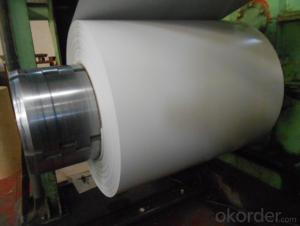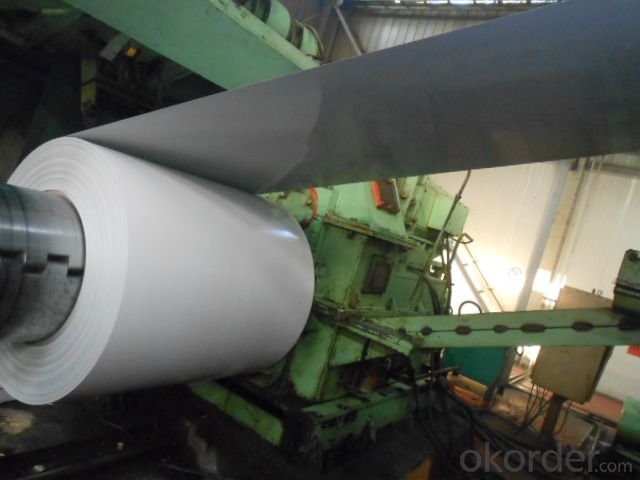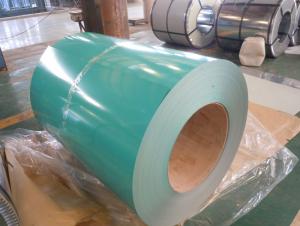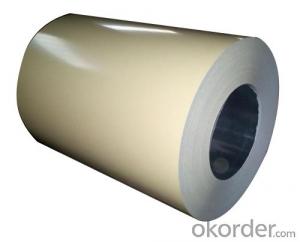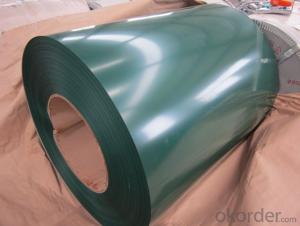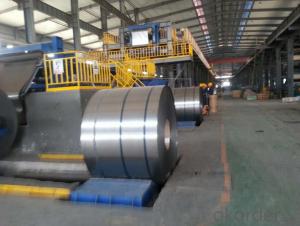Pre Painted Galvanized Steel coil In coil
- Loading Port:
- Tianjin
- Payment Terms:
- TT OR LC
- Min Order Qty:
- 25 m.t.
- Supply Capability:
- 2000 m.t./month
OKorder Service Pledge
OKorder Financial Service
You Might Also Like
Pre Painted Galvanized Steel Coil
Thickness: 0.3-0.8mm
Width: 914-1250mm
Inner Diameter: 508mm,610MM
Weight of Steel Coil: 3-13MT
Available Dipped Layer: 50-150g/m2
Type of coating structure: 2/1 Coat the top surface of the steel sheet twice, coat the bottom surface once, and bake the sheet twice.
Front Side Paint Thickness: 15-25μm
Back Side Paint Thickness: 5-10μm
Pattern: can be customized according to customers requirements.
Suitable for indoor or outdoor decoration, color lasting for at least 10 years for outdoor using, could for roll forming.
1. Pre Painted Steel Coil is coated with organic layer, which provides higher anti-corrosion property and a longer lifespan than that of galvanized steel sheets.
2. The base metals for Pre Painted Steel Coil consist of cold rolled, HDG electro-galvanized and hot-dip alu-zinc coated steel. The finish coats of Pre Painted Steel Coil can be classified into groups as follows: polyester, silicon modified polyesters, polyvinylidene fluoride, high-durability polyester, etc.
- Q: Which is more reactive? Zinc or Steel? And why?
- Zinc. Steel is an alloy consisting mostly out of iron, In the reactivity seris, zinc is more reactive than iron. Therefore, zinc is more reactive than steel
- Q: What are the different coil cutting methods used for steel coils?
- There are several coil cutting methods commonly used for steel coils, each with its own advantages and applications. These methods include shearing, slitting, and laser cutting. 1. Shearing: Shearing is a widely used method for cutting steel coils. It involves applying a high force to a set of blades, which cuts through the coil in a straight line. Shearing is ideal for cutting thick steel coils into smaller, more manageable sizes. It is a cost-effective method that can be used for high-volume production. 2. Slitting: Slitting is a process that involves cutting a wide coil into several narrower strips. This method is commonly used for steel coils that need to be transformed into various widths, such as those used in the manufacturing of automotive components, construction materials, and electrical appliances. Slitting machines use a set of circular knives to make precise cuts, ensuring minimal material loss and high accuracy. 3. Laser cutting: Laser cutting is a more advanced method that uses a high-powered laser beam to cut through steel coils. This process offers exceptional precision, allowing for intricate designs and complex shapes to be cut with ease. Laser cutting is suitable for thin to medium thickness steel coils and is often used in industries that require high-quality cuts, such as automotive, aerospace, and electronics. Each of these coil cutting methods has its own advantages and is chosen based on the specific requirements of the steel coils being processed. Factors such as coil thickness, desired accuracy, production volume, and the complexity of the cuts needed are all taken into account when determining the most appropriate cutting method.
- Q: What are the different finishes available for steel coils?
- There are several different finishes available for steel coils, each offering its own unique set of characteristics and benefits. Some of the most common finishes include: 1. Hot-dip galvanized: This finish involves immersing the steel coil in a bath of molten zinc, which creates a protective layer that prevents corrosion and rust. It provides excellent durability and long-term protection against harsh environmental conditions. 2. Electro-galvanized: Similar to hot-dip galvanizing, this finish uses an electrical current to apply a thin layer of zinc onto the steel coil. It offers good corrosion resistance and aesthetics, making it suitable for various applications. 3. Galvannealed: This finish combines the benefits of galvanizing and annealing processes. The steel coil is first galvanized and then annealed, resulting in a matte grey appearance with enhanced paint adhesion. Galvannealed finishes are commonly used in automotive and appliance industries. 4. Pre-painted: Also known as coil coating, this finish involves applying a layer of paint onto the steel coil before it is formed into its final product. Pre-painted finishes offer a wide range of colors, textures, and gloss levels, allowing for customization and improved aesthetics. 5. Stainless steel: Steel coils can also be finished with a layer of stainless steel, which provides excellent resistance to corrosion, heat, and chemicals. Stainless steel finishes are often utilized in applications where hygiene, durability, and a high-quality appearance are essential, such as in the food and beverage industry. 6. Cold-rolled: This finish involves passing the steel coil through a series of rollers at room temperature, resulting in a smooth, polished surface. Cold-rolled finishes offer improved dimensional accuracy, surface quality, and flatness, making them suitable for applications that require tight tolerances and a refined appearance. 7. Metallic coated: This finish involves applying a layer of a metallic coating, such as aluminum or zinc-aluminum alloy, onto the steel coil. Metallic coated finishes offer excellent corrosion resistance, lightweight properties, and aesthetic versatility. Overall, the choice of finish for steel coils depends on the specific requirements of the application, considering factors such as corrosion resistance, aesthetics, durability, and cost-effectiveness. It is important to consult with industry experts and manufacturers to determine the most suitable finish for a particular project.
- Q: How are steel coils protected against bending and deformation?
- Steel coils are protected against bending and deformation through the use of robust packaging materials, such as wooden crates or steel strapping, which provide structural support and prevent any external pressure from causing damage. Additionally, steel coils may be stored and transported in specialized racks or containers designed to evenly distribute weight and minimize the risk of bending or deformation.
- Q: How are steel coils inspected for damage during transportation?
- Steel coils are inspected for damage during transportation through various methods such as visual inspections, magnetic particle testing, ultrasonic testing, and dimensional checks.
- Q: and also what makes different hardness of stainless steel?
- The person above me is right .The stainless steel is used in shaving blades
- Q: How are steel coils used in the production of doors and windows?
- Steel coils are used in the production of doors and windows as they provide the raw material for manufacturing the frames and components. The coils are processed and shaped into the desired profiles, which are then used to construct the frames, sashes, and other structural elements of doors and windows. This ensures strength, durability, and stability in the final products.
- Q: What are the common applications of galvanized steel coils?
- Galvanized steel coils are commonly used in a variety of applications, including construction, automotive manufacturing, electrical appliances, and agricultural equipment. They are particularly useful for roofing and siding materials, as well as for creating durable and corrosion-resistant components in various industries.
- Q: What are the challenges in coil blanking for complex shapes?
- Coil blanking for complex shapes presents several challenges that need to be addressed in order to achieve accurate and efficient results. One significant challenge lies in the precise positioning and alignment of the coil material. Complex shapes often require intricate cutting patterns, and any misalignment or deviation can lead to inaccurate cuts and wasted material. Another challenge is the selection and optimization of the blanking tooling. Complex shapes often require specialized dies and punches, which need to be carefully designed and manufactured to ensure accuracy and consistency. This not only involves the selection of appropriate tooling materials but also the consideration of factors such as cutting forces, wear resistance, and tool life. The complexity of the shapes also poses challenges in terms of material deformation and springback. During the blanking process, the material undergoes various deformations and stresses, which can cause distortions and dimensional variations in the final product. Achieving the desired shape while minimizing these deformations requires a thorough understanding of material properties and advanced techniques such as compensation and adjustment in the die design. Furthermore, the high-speed nature of coil blanking for complex shapes can lead to increased vibration and noise levels. The dynamic forces involved in cutting intricate shapes can result in tool chatter and excessive noise, which not only affects the quality of the cut but also the overall operational efficiency. Implementing effective damping and vibration control measures, such as tool coatings and optimized cutting parameters, is crucial to mitigate these challenges. Lastly, the complexity of the shapes can also impact the overall production efficiency. Complex shapes often require longer tool setup times and more frequent tool changes, which can lead to increased downtime and reduced productivity. Additionally, the intricate nature of the cuts may require multiple passes or additional machining operations, further adding to the production time and complexity. To overcome these challenges, manufacturers need to invest in advanced technologies, such as computer-aided design and simulation software, to optimize the blanking process. Additionally, continuous research and development efforts focused on improving tooling materials, cutting techniques, and process control can help address the challenges associated with coil blanking for complex shapes.
- Q: How are steel coils inspected for chemical composition?
- Steel coils are inspected for chemical composition through a process known as spectroscopy. Spectroscopy involves the use of a spectrometer, which is an instrument that analyzes the light emitted or absorbed by a sample to determine its chemical composition. In the case of steel coils, a small sample is usually taken from the coil and prepared for analysis. This sample is then placed in the spectrometer, which emits a beam of light onto the sample. The light interacts with the atoms and molecules in the sample, causing them to emit or absorb specific wavelengths of light. The spectrometer measures the intensity of the emitted or absorbed light at different wavelengths and creates a spectrum, which is essentially a unique fingerprint for the sample. This spectrum is then compared to a database of known spectra for different elements and compounds to determine the chemical composition of the steel. The spectroscopic analysis can identify the presence and concentration of various elements such as carbon, manganese, phosphorus, sulfur, and other trace elements that may be present in the steel. These elements play a crucial role in determining the steel's properties, strength, and suitability for different applications. Inspection for chemical composition is essential in the steel industry to ensure that the steel meets the required specifications and standards. Any deviation from the desired chemical composition can affect the steel's performance and may lead to structural failures or other defects. Overall, spectroscopy provides a highly accurate and reliable method for inspecting steel coils for their chemical composition, helping to ensure the quality and integrity of the steel products.
Send your message to us
Pre Painted Galvanized Steel coil In coil
- Loading Port:
- Tianjin
- Payment Terms:
- TT OR LC
- Min Order Qty:
- 25 m.t.
- Supply Capability:
- 2000 m.t./month
OKorder Service Pledge
OKorder Financial Service
Similar products
Hot products
Hot Searches
Related keywords
